Your solar cooker takes longer to cook rice because it relies solely on the sun's energy, reaching lower maximum temperatures (250-400°F) compared to traditional stovetop methods (500°F+). While your stove provides instant, consistent heat, solar cooking depends on factors like sunlight intensity, time of day, and weather conditions. You'll notice cooking times extending 1.5 to 3 times longer than usual, especially during non-peak sun hours or cloudy days. The type of solar cooker you're using also impacts speed – box cookers provide steady but slower cooking, while parabolic designs offer more intense, focused heat. Understanding these factors can help you optimize your solar cooking experience.
The Science Behind Solar Rice
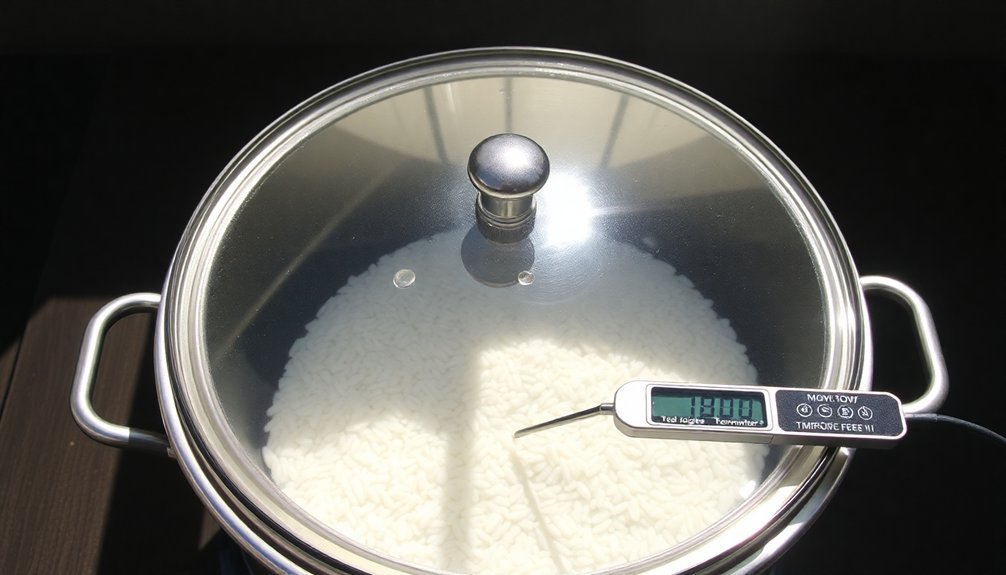
Through the remarkable process of solar cooking, sunlight transforms into the heat energy needed to cook rice. When sunlight enters your solar cooker, it's converted into infrared radiation as it interacts with the molecules inside. The dark-colored interior of your cooker absorbs this radiation more effectively, which is why you'll often find black surfaces inside these devices.
Your solar cooker traps this heat using a transparent cover, typically made of glass or plastic, creating a greenhouse effect. Short-wave radiation enters easily but long-wave radiation can't escape, causing the temperature to rise and maintain the heat needed for cooking. Having reflective materials positioned strategically around your cooker helps concentrate more sunlight onto your rice, increasing the overall cooking efficiency.
The design of your cooker plays an essential role in how efficiently it captures and distributes this heat. Box cookers use reflectors to direct more sunlight onto the cooking area, while parabolic designs concentrate sunlight to a single point for higher temperatures.
You'll need to guarantee your rice gets consistent heat exposure throughout the cooking process, which is why it takes 6-7 hours. The cooker's ability to retain heat through proper insulation and thermal storage materials determines how effectively your rice will cook, especially during periods of variable sunlight.
Sunlight Intensity Affects Cooking Speed
Now that you understand how solar cooking works, the intensity of sunlight becomes a major factor in your cooking success. You'll get the best results between 11:00 am and 3:00 pm when sunlight is strongest, particularly in the two hours before and after local solar noon. Outside these peak hours, you'll need to extend your cooking time considerably.
Weather conditions will dramatically affect your rice cooking time. On clear, sunny days, your solar oven can reach temperatures above 250°F, but partially cloudy conditions will drop this to 200-250°F. You'll need to plan for cooking times that are 1.5 to 3 times longer than conventional methods. Using a matte black pot will help maximize heat absorption and improve cooking efficiency.
Your geographic location also matters. Your latitude affects sunlight angle and intensity, while factors like altitude and local climate impact how much solar energy reaches your cooker.
You'll want to avoid shadows from buildings or plants that could block direct sunlight. It's crucial to monitor your cooking progress with a meat thermometer rather than relying on fixed times, as conditions can change throughout the day.
Remember to adjust your cooking schedule based on daily weather forecasts and local environmental conditions.
Choosing Your Solar Cooker Type
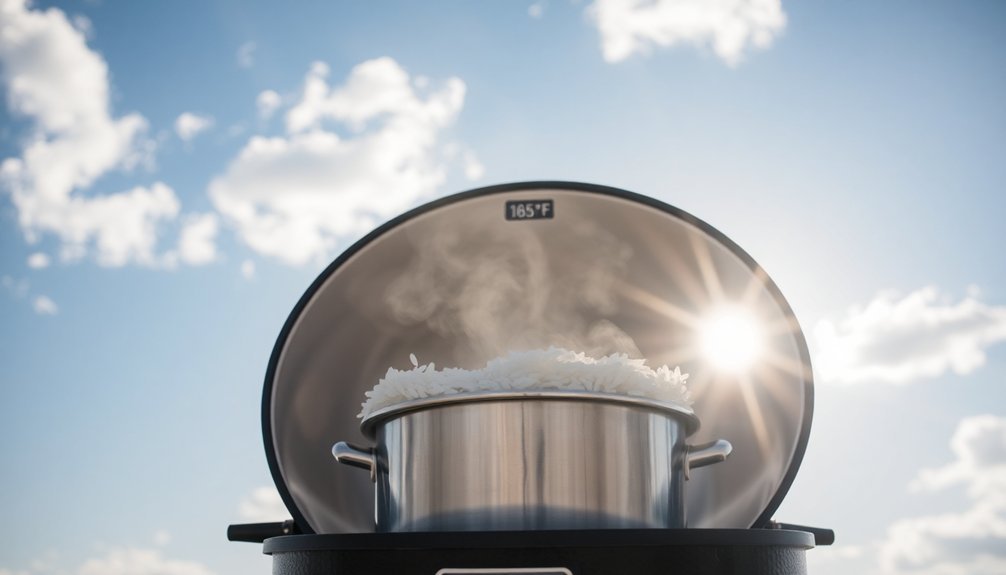
When cooking rice, you'll find box cookers and parabolic cookers offer distinct advantages.
Box cookers provide steady, even heat distribution through trapped air, while parabolic cookers deliver intense, focused heat at a single point.
Your box cooker will maintain more consistent temperatures between 250-400°F through its insulated walls and reflective interior, making it ideal for larger batches of rice. A key feature of box cookers is their ability to use heat-resistant plastic bags for baking and steaming tasks.
Parabolic cookers can reach higher temperatures above 250°C and heat faster, but you'll need to adjust them frequently to track the sun and maintain proper heat distribution.
Box Vs Parabolic Performance
Choosing between box and parabolic solar cookers depends heavily on your cooking needs and lifestyle.
Box cookers maintain temperatures between 200°F and 350°F, making them ideal for rice and other foods that benefit from slow, steady cooking. You'll find they're more forgiving since they require minimal sun tracking and are nearly impossible to burn food in.
Parabolic cookers, on the other hand, can reach temperatures above 250°C, allowing you to cook your rice faster. However, you'll need to adjust them frequently to maintain ideal cooking conditions. While they're quicker, they typically handle smaller portions than box cookers, which can accommodate multiple dishes simultaneously.
If you're new to solar cooking, you'll likely prefer a box cooker's ease of use and stability. They're also more cost-effective and can be built from recycled materials.
But if speed is your priority and you don't mind the extra attention required, a parabolic cooker might be your better choice. Consider that box cookers excel at retaining heat and cooking larger quantities, while parabolic models offer the versatility of conventional stovetop cooking methods like frying and grilling.
Heat Distribution Methods
Understanding heat distribution methods is essential for selecting the right solar cooker for your needs. Each type offers distinct advantages in how it captures and distributes heat for cooking rice.
| Feature | Heat Method | Best For |
|---|---|---|
| Panel Cookers | Direct reflection | Simple cooking, small portions |
| Box Cookers | Heat trapping | Multiple dishes, baking |
| Parabolic Cookers | Concentrated focus | High-heat cooking, fast results |
| Tube Cookers | Vacuum insulation | All-weather cooking, consistency |
| Hybrid Systems | Combined methods | Versatile cooking needs |
You'll find that tube cookers offer the most consistent heat distribution through their vacuum technology, making them ideal for rice cooking in various conditions. Box cookers provide stable, even heat that's perfect for larger quantities, though they'll take longer to reach cooking temperature. If you're looking for quick results, parabolic cookers deliver intense, focused heat but require more attention to prevent burning. Panel cookers, while simple and affordable, distribute heat less effectively and need frequent adjustments to maintain proper cooking temperatures. For rice specifically, you'll want to take into account a cooker that maintains steady temperatures rather than one that delivers intense but inconsistent heat.
Best Times for Solar Cooking
Since successful solar cooking relies heavily on sunlight intensity, timing your cooking session is essential for the best results. You'll need at least 6-7 hours of bright sunlight, with late morning to early afternoon being the ideal window when the sun's rays are strongest.
To get started, you'll want to preheat your solar oven for up to an hour before cooking. The internal temperature can reach about 200°F on a sunny day, though this varies by cooker type. Parabolic cookers like the SunGlobe work faster than box-type ovens, which typically reach 125-200°F.
For rice specifically, you'll spend about 5 minutes on preparation, followed by 20-30 minutes of cooking time. However, if you're reheating rice, expect it to take around 5 hours with a small amount of added water. You'll need to stir every 10-15 minutes and reposition your cooker to follow the sun's path.
Remember to use the correct water-to-rice ratio (typically 1:1.25) and keep the pot covered to retain steam.
Don't start cooking too late in the day, as you'll need sufficient sunlight to complete the process.
Seasonal Impact on Rice Preparation
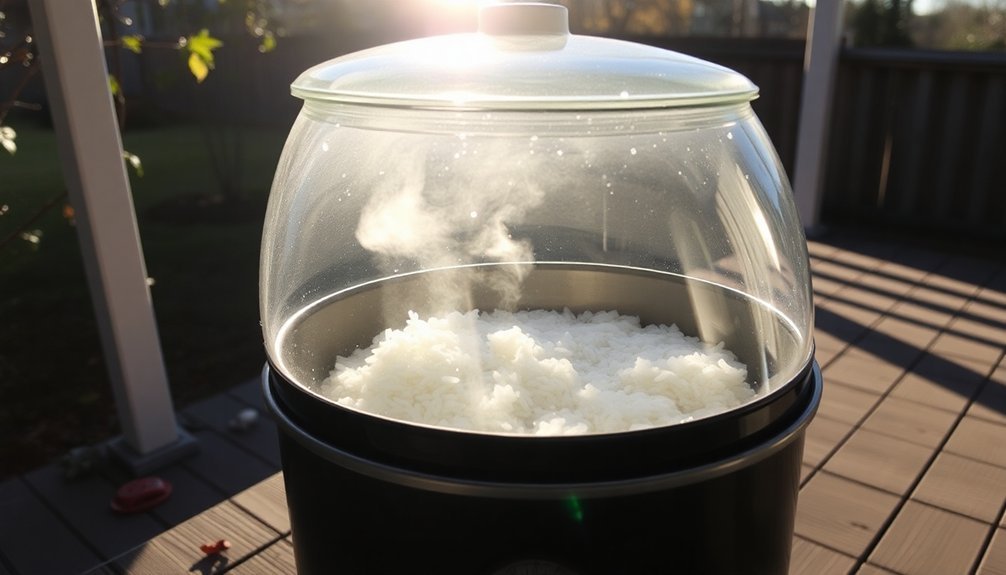
The success of your solar-cooked rice depends heavily on the seasonal conditions you'll encounter throughout the year. During summer, you'll find your rice cooks faster due to intense direct sunlight, while winter's lower sun angle will greatly extend cooking times. You'll need to adjust your cooking schedule based on these seasonal variations.
| Season | Cooking Time Impact | Required Adjustments |
|---|---|---|
| Summer | Shortest cooking times | Position cooker early morning |
| Spring/Fall | Moderate cooking times | Add 30-60 minutes to usual time |
| Winter | Longest cooking times | Start before peak sun hours |
| Monsoon | Highly variable | Have backup cooking method ready |
Your location plays a vital role in solar cooking efficiency. If you're closer to the equator, you'll experience more consistent cooking times year-round. However, you'll need to account for seasonal weather patterns that can affect your success. During cloudy or windy conditions, you'll want to protect your solar cooker and potentially extend cooking times. In colder seasons, you should preheat your cooker longer and consider using wind shields to maintain ideal temperature. Remember that geographical features like buildings or trees can create seasonal shadow patterns that'll affect your cooker's placement.
Water to Rice Ratios
Proper water measurements form the foundation of perfectly solar-cooked rice. When you're using a solar cooker, you'll need to adjust traditional water-to-rice ratios to accommodate the unique cooking environment. Long grain rice typically requires 2 cups of water per cup of rice, while short grain varieties need about 1.25 cups of water per cup of rice.
You'll want to add extra water when solar cooking – anywhere from half to a full dose more than conventional cooking methods. This adjustment compensates for the slower heating process and potential water loss during extended cooking times.
For example, if you're cooking basmati or jasmine rice, which normally use 1.5 cups of water per cup of rice, you might need up to 2.5 cups of water in a solar cooker.
Starting with hot water can greatly improve your results, especially in less efficient solar cookers. Remember that altitude and humidity will affect water absorption, so you'll need to monitor the cooking process and adjust accordingly.
It's crucial to measure your ingredients precisely and consider using a lid to retain moisture, ensuring your rice doesn't dry out during the longer cooking period.
Proper Pot Selection Matters
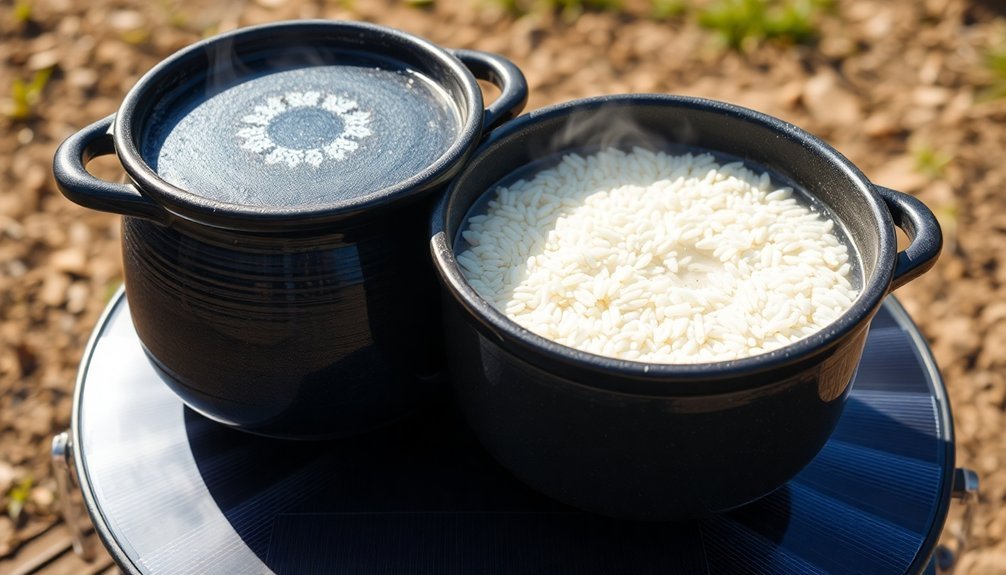
You'll want to choose a black or dark-colored pot for solar cooking rice since these colors absorb sunlight more efficiently and convert it to heat faster than light-colored containers.
For the best results, select thick-walled black enameled steel pots, which combine excellent heat absorption with superior heat retention properties.
The pot's ability to maintain consistent temperatures through its material thickness and dark surface coating will help guarantee your rice cooks evenly and thoroughly.
Dark Pots Heat Faster
Selecting dark-colored pots makes a significant difference in solar cooking efficiency. When you're cooking rice in a solar cooker, you'll want to use dark or black pots because they absorb sunlight more effectively and convert it into heat.
If you use light-colored or shiny pots, they'll reflect sunlight away, reducing your cooking efficiency and extending the cooking time unnecessarily.
You'll achieve the best results with thin, dark metal pots, as they heat up faster than heavy alternatives like cast iron. While cast iron retains heat longer, it takes much more time to reach cooking temperature initially.
Choose lightweight vessels with lower thermal mass, such as dark enamel or speckleware cookware. If you need to darken your pot, use non-toxic paint that's safe for cooking.
For peak performance, verify your dark pot has a well-fitting lid to retain heat. When combined with a transparent heat trap like a glass or plastic cover, you'll create an efficient cooking environment.
This setup works effectively in most solar cooker designs, though parabolic cookers may have different requirements due to their focused light patterns.
Heat Retention By Material
Materials play an essential role in how effectively your solar cooking pot retains heat. When choosing cookware for solar cooking rice, you'll want to evaluate both the material's ability to conduct and retain heat.
While aluminum holds twice as much heat as cast iron or stainless steel pound for pound, the total mass of your pot matters considerably for heat retention. Your pot's thermal mass directly affects how well it maintains cooking temperature, especially during cloudy periods or when the sun's intensity varies.
You'll get better results with thicker, heavier cookware that can store more heat energy. When cooking rice specifically, remember that the water content plays a vital role in heat retention, often holding more heat than the pot itself.
- Copper and aluminum excel at heat conduction but may need more mass for ideal retention
- Multi-layer pots combining different metals offer both good conductivity and retention
- Heavy-bottomed pots take longer to heat initially but maintain more consistent temperatures
The key is finding the right balance between heat conductivity and retention. While thin aluminum pots heat quickly, they'll lose heat faster than thicker alternatives, potentially extending your rice cooking time.
Weather and Temperature Considerations
When planning to cook rice using solar power, understanding the weather and temperature conditions is essential for success.
You'll achieve the best results during summer months between 10:00 AM and 4:00 PM when sunlight is most intense. During winter, you're limited to a shorter window between 11:30 AM and 2:30 PM, while fall and spring offer intermediate cooking times from 11:00 AM to 3:00 PM.
Your solar cooker's performance depends heavily on available sunlight and temperature. On clear, sunny days, you can expect temperatures up to 250°F or higher, which will cook your rice more quickly.
However, if it's partially cloudy, temperatures might only reach 200-250°F, requiring you to double your cooking time. You'll need to maintain proper orientation to the sun throughout the cooking process for ideal results.
Weather conditions greatly impact your cooking success. You'll want to check the forecast before starting, as cloudy skies will reduce efficiency.
It's also important to position your cooker away from wind and shade. While solar cooking is possible year-round, you'll need to adjust your cooking times and expectations based on seasonal variations and current weather conditions.
Rice Varieties and Cooking Duration
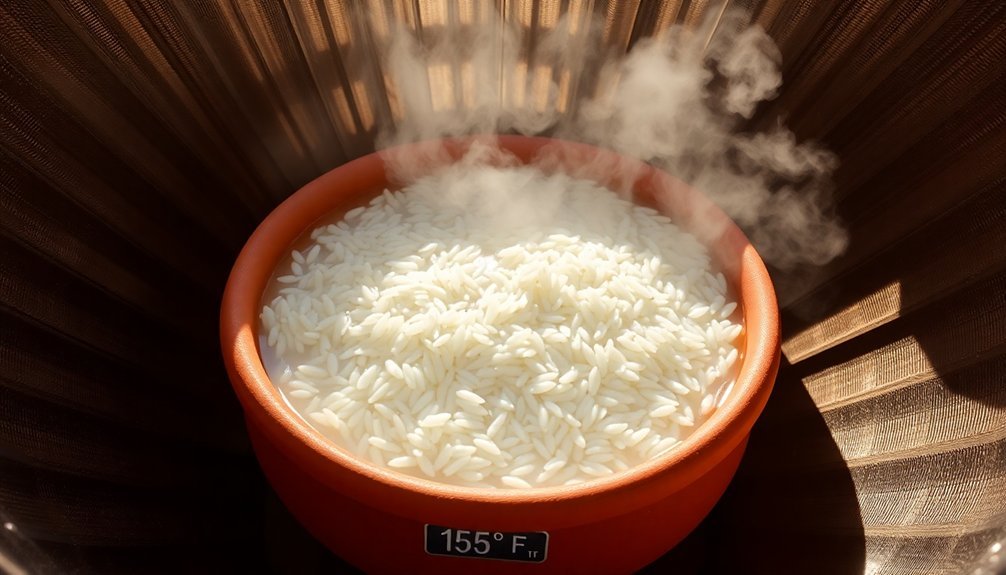
Different rice varieties require distinct cooking times and water ratios when using a solar cooker. In conventional cooking, long-grain white rice typically cooks in 16-18 minutes, while brown rice needs 30 minutes. However, you'll need to extend these times considerably when solar cooking due to lower, more variable temperatures.
The starch content and grain structure of your rice will impact how it cooks in a solar cooker. Short-grain varieties like sushi rice contain more starch and tend to cook faster than long-grain varieties, while brown rice takes the longest due to its intact bran layer.
You'll need to adjust your water ratios accordingly:
- Long-grain white rice requires a 1½:1 water-to-rice ratio, making it ideal for solar cooking as it's less likely to become mushy.
- Short-grain sushi rice needs a 1¼:1 ratio but requires careful monitoring to prevent overcooking due to its high starch content.
- Brown rice demands a 1¾:1 ratio and considerably more cooking time, so you'll want to start earlier in the day when solar cooking.
Remember that different cooking methods affect timing – while a rice cooker might prepare basmati in 15 minutes, solar cooking will take considerably longer.
Heat Retention Techniques
Your rice will cook more efficiently when you use a dark pot with a tight-fitting lid, as these elements maximize heat absorption and prevent steam from escaping.
You'll get the best results using black cast iron or dark glass cookware, which can absorb up to 95% of the solar radiation and convert it into cooking heat.
Keep your pot well-insulated during the cooking process by surrounding it with materials like rockwool or fiberglass, leaving only the glazed surface exposed to capture sunlight.
Lid Material and Design
Since heat retention plays a vital role in solar cooking, choosing the right lid material and design can make or break your rice-cooking success. You'll want to select a lid that creates a tight seal and prevents moisture from escaping, as this is essential for properly cooking rice. Dark-colored lids, particularly those made from metal or ceramic materials, are your best choice because they absorb and retain heat more effectively.
For ideal rice cooking performance, consider these key lid features:
- Metal lids, especially cast iron or enameled options, offer superior heat retention and quick warming properties.
- A tight-fitting design prevents moisture loss and keeps condensation from dripping onto your solar oven's glazing.
- Dark or black surfaces enhance heat absorption, which is particularly important when cooking light-colored foods like rice.
You'll achieve better results by combining your lid choice with proper insulation techniques. Consider adding insulating materials around the lid's edges and ensuring it works effectively with your solar oven's glazing system.
Remember that maintaining consistent temperature is vital when solar cooking rice, so you should keep the lid in place throughout the entire cooking process.
Dark Pot Advantages
Building on proper lid selection, the choice of a dark-colored pot becomes a cornerstone of successful solar rice cooking. Dark pots excel at absorbing sunlight and converting it into the heat needed for cooking rice effectively.
You'll find that dark-colored surfaces maximize radiant energy absorption, while lighter or reflective surfaces won't achieve the same heating efficiency.
When selecting your pot, opt for thin-walled metal vessels rather than thick ceramic or earthenware options. These thin metal pots heat up faster and distribute heat more uniformly throughout your rice.
If you're painting a pot dark, make sure you use non-toxic paint that's safe for cooking. While cast iron pots can work, they'll require intense sunshine and longer cooking times due to their thickness.
To enhance your dark pot's effectiveness, you'll need to position it correctly in peak sunlight hours, typically between 10 AM and 4 PM during summer months.
Remember to adjust the pot's position every 30-45 minutes to maintain ideal sun exposure. If clouds appear before your rice is fully cooked, you can rely on the pot's heat retention to continue the cooking process.
Insulation During Cooking
Effective insulation in and around your solar cooker plays an essential role in maintaining consistent temperatures for rice cooking. You'll want to guarantee your cooker has proper insulation on all sides except the glazed top, using materials like fiberglass, rockwool, or cellulose.
Double-glazed glass panels with an air space between them can cut heat loss in half, helping maintain the steady temperature needed for perfectly cooked rice.
To maximize heat retention while cooking rice, you should:
- Cover your cooking pot with a tight-fitting lid and use plastic wrap to prevent condensation on the oven glass
- Line the inside of your box lid with aluminum foil to reflect heat back onto your rice pot
- Seal all seams with tape to eliminate any gaps where heat might escape
The depth of your solar cooker matters too – a shallower box reduces heat loss area and leads to higher cooking temperatures.
Remember to place a vapor barrier on the innermost surface to prevent moisture damage, and guarantee your insulation materials create a solid barrier between the inner and outer box materials.
These techniques will help your rice cook more efficiently and consistently.
Geographic Location and Sun Angles
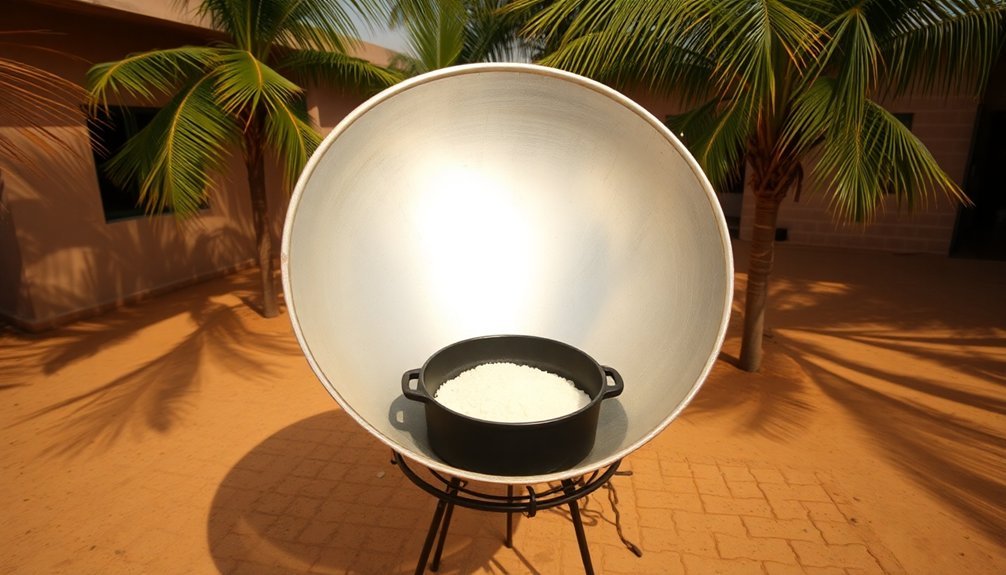
Geographic location plays three essential roles in solar cooking success: latitude, sun angle, and seasonal timing. If you're near the equator, you'll benefit from more direct sunlight and consistent cooking conditions throughout the year.
However, if you're in higher latitudes, you'll face greater challenges, especially during winter months when the sun's rays are less direct.
Your location's sun angle directly affects how efficiently you can cook rice. The more direct the sun's rays, the better your cooking results will be. You'll need to adjust your solar cooker's position throughout the day to maintain ideal exposure, particularly if you're in northern or southern regions where the sun's path varies considerably.
Seasonal changes will impact your solar rice cooking schedule. During summer, you can cook between 10:00 AM and 4:00 PM, but winter limits your ideal cooking window to between 11:30 AM and 2:30 PM.
You'll need to plan accordingly and may require longer cooking times during non-summer months. While elevation can help by reducing atmospheric filtering, clear skies and direct sunlight remain the most essential factors for successful solar rice cooking.
Solar Cooker Positioning Tips
Proper positioning of your solar cooker can make the difference between a perfectly cooked meal and undercooked rice. You'll need to find a sunny spot away from shadows and strong winds, then point your cooker directly into the sun. For maximum efficiency, verify sunlight strikes the glass or reflective surface at a 90-degree angle.
The sun's movement requires constant attention to maintain peak cooking temperatures. You should adjust your cooker every 30-45 minutes, though parabolic cookers need more frequent adjustments to maintain their focal point. It's smart to position your cooker slightly ahead of the sun's perfect position to verify continuous heating throughout the cooking process.
- Keep the reflectors and glass cover clean to maximize sunlight capture
- Use black cooking pots or paint your pots black to enhance heat absorption
- Place your pot in a high-temperature baking bag to retain heat
To maintain cooking efficiency, resist opening the box unnecessarily, as this can cause significant temperature drops. Remember to vent the box properly to prevent steam buildup, and always use sun protection and potholders when handling the equipment.
Frequently Asked Questions
Can Bugs or Insects Get Into Solar-Cooked Rice Left Outside?
Yes, your solar-cooked rice is highly vulnerable to insect infestation when left outside. Bugs like rice weevils can easily find and infest it. You'll need airtight containers to protect your cooked rice.
Will Solar-Cooked Rice Have the Same Texture as Conventionally Cooked Rice?
Yes, you'll get the same texture as conventionally cooked rice if you follow proper water ratios and timing. With solar cooking's slow heating, you can achieve perfectly cooked rice that's just as fluffy.
Is It Safe to Leave Rice in a Solar Cooker Overnight?
No, you shouldn't leave rice in a solar cooker overnight. It'll sit in the temperature danger zone (50-125°F), allowing harmful bacteria to grow. Always refrigerate your cooked rice promptly to prevent food poisoning.
Can Presoaking Rice Reduce Solar Cooking Time Significantly?
While presoaking can help with rice texture, it won't greatly reduce your solar cooking time. You'll still need strong sunlight and proper cooker design for efficient cooking, regardless of whether you presoak.
Does Altitude Affect How Long It Takes to Solar Cook Rice?
Yes, altitude will affect your rice's solar cooking time. Since water boils at lower temperatures in high altitudes, you'll need more time to properly cook rice. Plan to increase cooking duration accordingly.
In Summary
You'll find solar cooking rice takes longer due to the variable nature of sunlight and heat distribution. While traditional stovetops provide constant, concentrated heat, solar cookers rely on environmental factors. To speed up the process, choose the right cooker design, position it ideally, and cook during peak sun hours. Don't forget that your location, season, and rice variety all play significant roles in cooking duration.

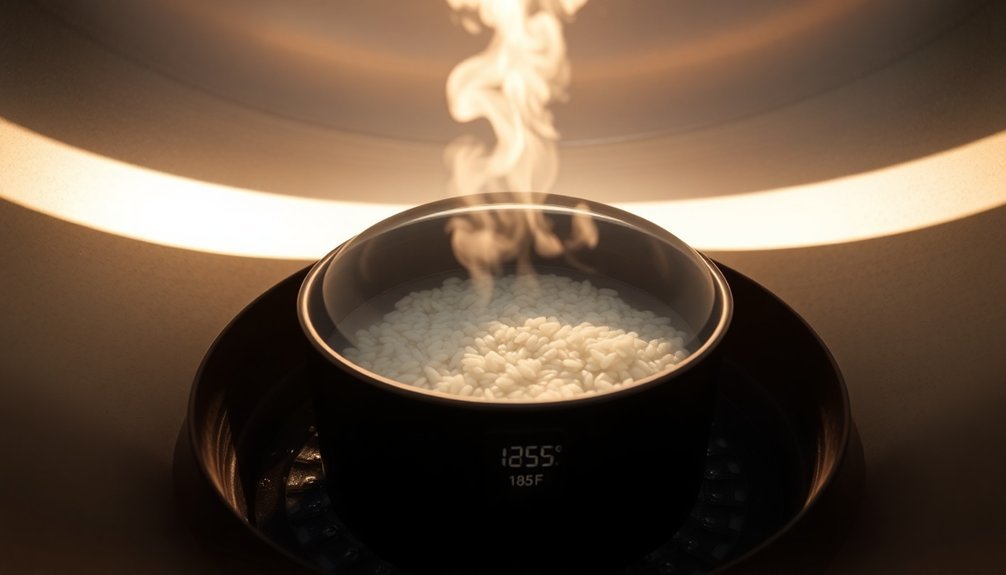
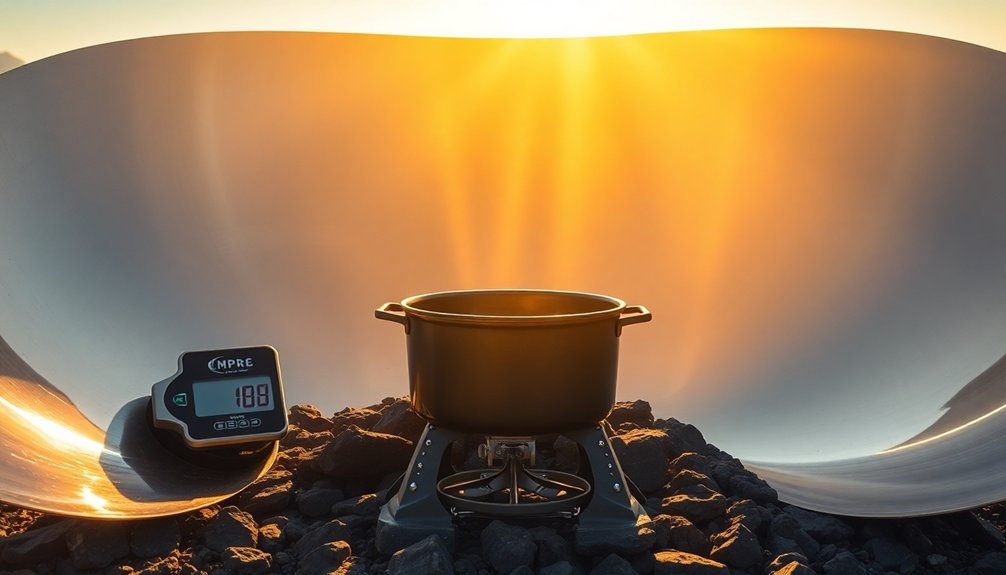
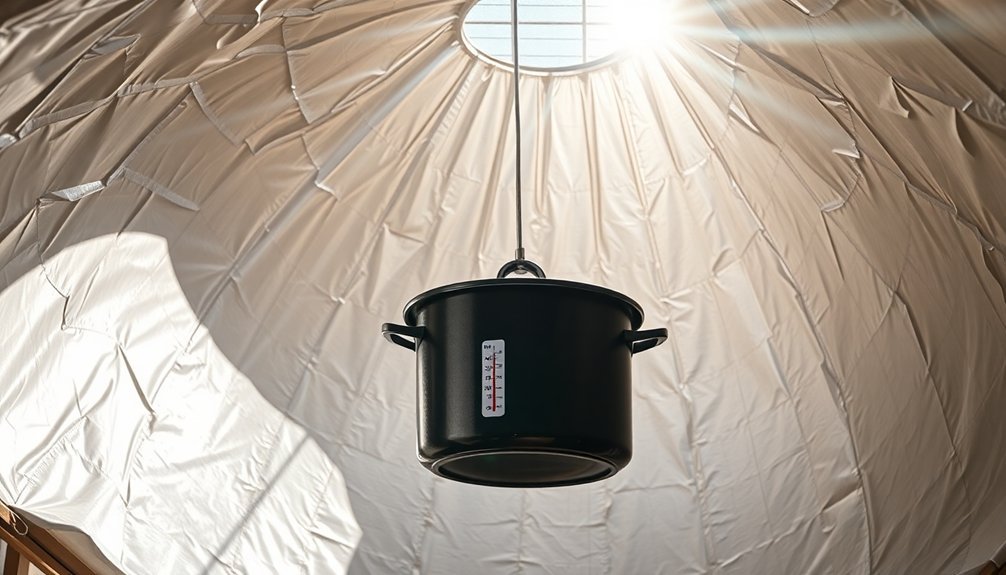

Leave a Reply